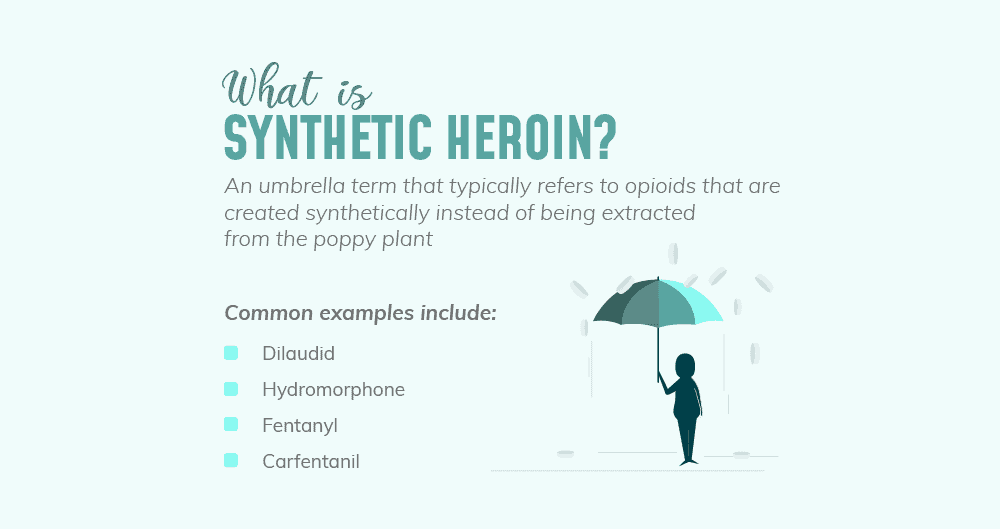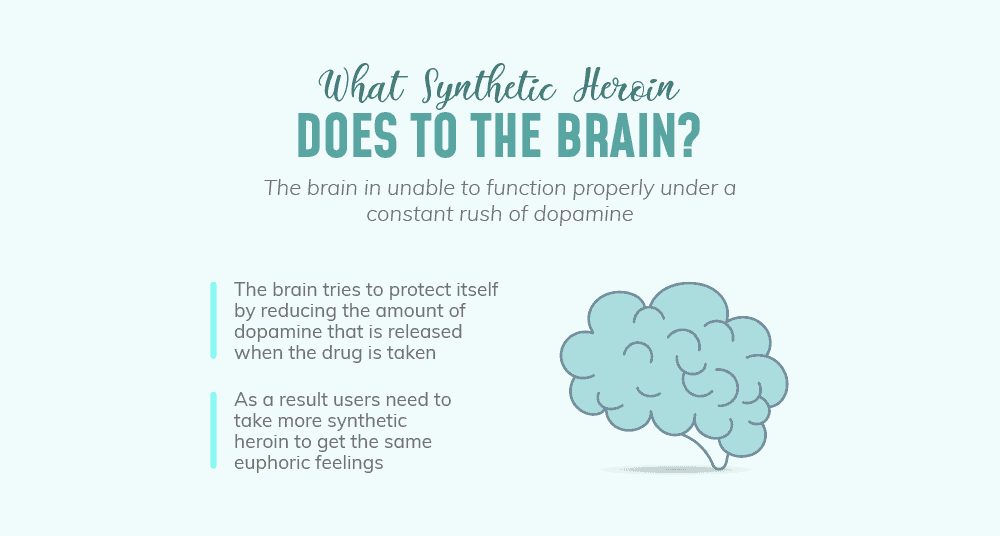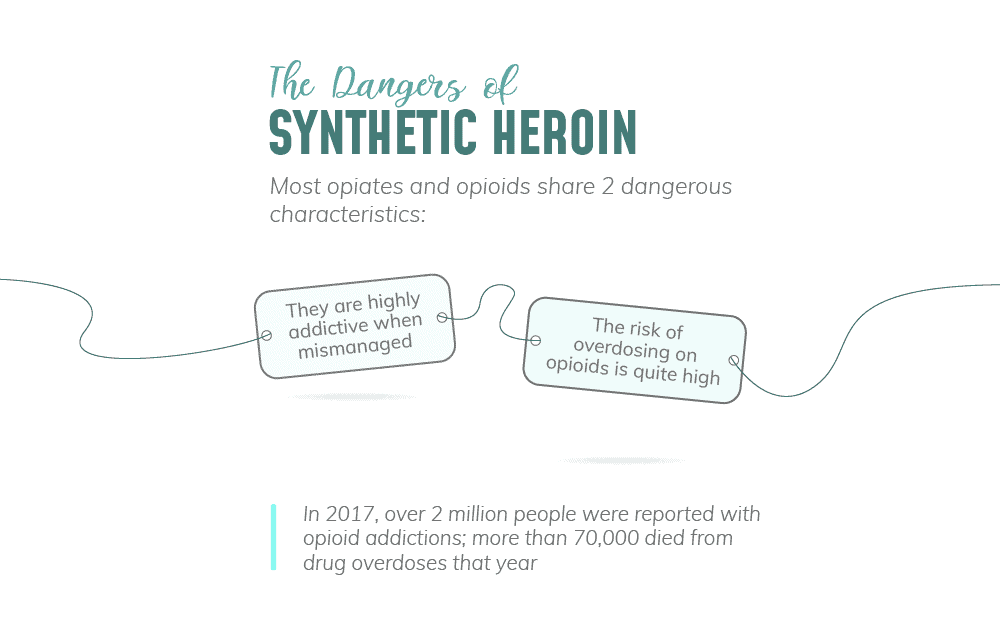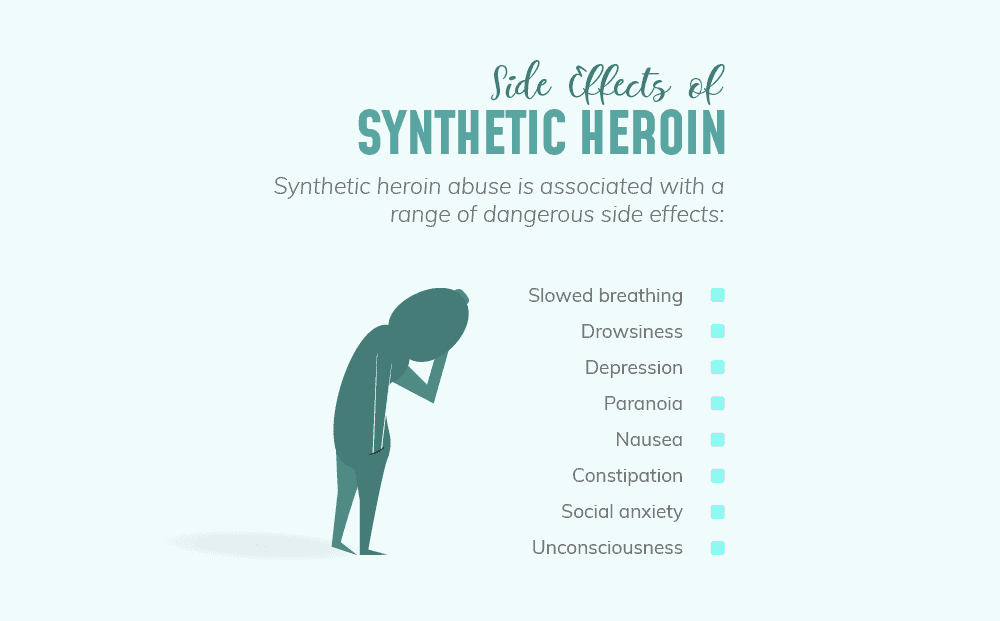You have most likely heard of heroin, morphine and opioids – but are you familiar with the dangers of synthetic heroin? What about synthetic morphine or fentanyl? Not all dangerous and addictive drugs are illegal. Prescription opioid drugs are just one example of how the use of scheduled substances can turn into an addiction if precautions are not taken. More than that, the abuse of medication like morphine, oxycodone, and fentanyl can lead to the abuse of dangerous street drugs, like synthetic heroin. 
Synthetic Heroin & Opioids in the United States
So what are the dangers of synthetic heroin, exactly? While this post will dive into the details, the biggest risk in using synthetic heroin is the possibility of a fatal overdose. There is no way around it: synthetic opioids can be deadly.
“The rate of fatal overdoses in the U.S. involving synthetic heroin nearly doubled from 2013 to 2014, climbing from 3,105 deaths to 5,544. The Centers for Disease Control says heroin laced with fentanyl drove the increase.”
~ Keegan Hamilton, writing for Vice News
As the Vice article outlines, the abuse of heroin and similar synthetic opioids is on the rise in the United States. The spike is likely to be even sharper from the past couple of years. Because of this danger, it is crucial to understand what synthetic heroin and synthetic morphine are, how they work, and what warning signs of heroin addiction to look for.
The Basics of Synthetic Heroin & Morphine
Opiates have a long history of both recreational and medical purposes. Several modern-day opioid drugs originate from the opium plant (or poppy plant), including morphine and codeine. Today, most prescription opioids are synthetic. This means that they are manmade, and only mimic the effects of the drugs naturally found in opiates. Natural opiates include opium, morphine, and codeine. Opium is no longer used for medical purposes, but both morphine and codeine continue to circulate as controlled substances for pain relief. Codeine is the more commonly abused of the two natural opiate medications – often as a prescription-strength cough syrup. 
The Various Types of Natural and Synthetic Opioids
In contrast, synthetic and semi-synthetic opioids include methadone, fentanyl, heroin, oxycodone, and hydrocodone. These are generally considered even more dangerous than natural opiates since they are commonly abused and can be highly addictive.
- Morphine: The most active ingredient in the opium plant, morphine is a powerful painkiller. While still used in some settings, morphine is not prescribed as often as it used to be. Some alternatives (like fentanyl or oxycodone) have taken its place.
- Heroin: This is one of the most commonly abused forms of opioid drugs, along with prescription medication. Made from morphine, heroin is essentially a natural substance taken from the poppy plant. Once it enters the brain, the drug changes back into morphine and has the same euphoric effect.
- Opioids: A class of drugs that includes both morphine and heroin. An opioid drug is simply one that either originates from the poppy plant or is a synthetic recreation of the effects of these drugs.
In more recent years, synthetic heroin has become increasingly popular as more and more people become addicted to opioids.
- Synthetic Morphine: Synthetic morphine is essentially another word for some common narcotic painkillers. These include oxycodone, hydrocodone, methadone and buprenorphine. Some of the specific brands are outlined below.
- Synthetic Heroin: A manmade substitute for naturally occurring heroin. Synthetic heroin is often partially natural heroin mixed with other, more potent, ingredients.
It is worth noting that, sometimes, synthetic heroin refers to methadone, since it is used in treatment for heroin addiction. Methadone is used by some as a way to avoid the withdrawal effects of heroin addiction. However, there is another dangerous form of synthetic heroin on the market: heroin laced with fentanyl and carfentanil.
“Our Rehab Program treats addiction to synthetic heroin and any co-occurring disorder. – Learn More”
What Synthetic Heroin and Synthetic Morphine Do
The major danger in using synthetic heroin is the possibility of an overdose. While this risk is present in nearly every kind of legal and illegal drug, individuals using synthetic heroin are particularly susceptible to the danger of an overdose. This is because of how synthetic heroin (and synthetic morphine) work in the body. This type of drug is especially potent, which means it is especially dangerous. Synthetic heroin (like fentanyl) works by blocking the receptors in the brain that have to do with both emotions and with the sensation of pain. As a side effect, opioids like synthetic heroin increase the dopamine found in the brain. This is what causes people to become addicted to opium and heroin in the first place. It is also what brings on the risk of an overdose. The high dopamine levels experienced in the first hit drive users to use higher and higher doses of the drug to reach the same feeling of euphoria. However, the body naturally builds up a tolerance to the effects of the drug. Over time, this can lead to an inadvertent overdose. The risk of overdose becomes even greater with synthetic heroin because of what the drug does to the brain.
Types of Prescription Opioids to Be Wary Of
While prescription fentanyl is probably the most common form of synthetic heroin, the name also describes another drug: when heroin is mixed with carfentanil (an analog of fentanyl). Like fentanyl, carfentanil is extremely potent and dangerous. Because carfentanil is cheaper and easier to make than heroin, it has become increasingly common for drug users to unknowingly by heroin laced with the powerful drug. The danger in using these synthetic opioids is in the unknown: buying synthetic heroin on the street, you have no idea how much active, highly potent ingredients are mixed in with the heroin.
“While fentanyl is still the most common illicit synthetic opioid in the U.S., more obscure variations – such as acetylfentanyl, valerylfentanyl, and furanylfentanyl – have also started turning up on a regular basis.”
~ Keegan Hamilton, writing for Vice News
Of course, the other form of synthetic opioid can be dangers and detrimental to one’s physical health as well. Synthetic morphine can be risky as well if precautions are not taken.
Brands of Synthetic Morphine to Look Out For
Morphine is considered a natural opioid product. But over the years many medications have replaced morphine with synthetic morphine – an equivalent opiate analgesic with a much higher potency. Because they are so potent, synthetic morphine replacements can be highly addictive – and even dangerous when they are abused. Synthetic morphine equivalents may have a high risk of addiction and abuse, but they are unfortunately very common in the United States. Prescriptions for prescription opioids have skyrocketed in the past twenty-five years – from 76 million prescriptions in 1991 to over 200 million prescriptions in 2013. There are certainly valid medical purposes for using synthetic opiates. However, at the very least you should know that these prescription drugs could pose a risk, especially if you are already prone to addictive behaviors or substance abuse. The most common brands of synthetic morphine to be on the lookout for include:
- Demerol
- Fentanyl
- Lortab
- Atarax
- Norco
- Dilaudid
- Sufentanil
- Ultiva
Out of these brands of synthetic morphine, fentanyl is by far the most dangerous. It may not necessarily be the most commonly prescribed and abused drug in the United States. However, fentanyl has accounted for more than a quarter of deaths caused by all forms of synthetic opiates.
“Get the help you need today. We offer outpatient assistance, so you can maintain your work, family, and life commitments while getting the help you deserve!”
Be Aware of The Dangers of Synthetic Heroin
As with most drugs, there are two main dangers when it comes to using synthetic heroin:
- The danger of a lethal overdose; and
- The danger of becoming addicted to the drug
The Danger of Addiction to Synthetic Opioids
In the United States, an estimated 2 million people are addicted to prescription opioids, while around 500,000 people are addicted to heroin. There is no exact number of how many people are addicted to synthetic heroin. But given the fact that the drug is essentially a mix of heroin and other synthetic opioids, there is no question that it is highly addictive. Once addiction takes hold, it is difficult to overcome the subsequent dependency without professional help. Addiction is a mental disease that essentially strips a person of their ability to think rationally about their drug use. They just have to take the next hit – a hit that could be deadly.
The Danger of Overdosing on Synthetic Opioids
Heroin, as well as any other form of opioid drug, already presents a risk of overdose to those who use them. However, synthetic heroin poses an even greater risk of a deadly overdose. An overdose typically occurs once someone is already addicted to heroin. As an addict keeps upping the amount of opioids that they take, they overwhelm their system with dire consequences. However, because synthetic heroin can hide highly potent synthetic drugs like fentanyl and carfentanil, there is a greater chance of overdose even for a person who is using the drug for the first time.
“With drugs purchased on the street, you don’t know what you’re taking. You’re injecting yourself with a loaded gun.”
~ Tim Pifer, director of the New Hampshire State Police Forensics Lab
Understand the Side Effects of Synthetic Heroin
With literally hundreds of thousands of labs producing synthetic drugs, finding heroin mixed with another more potent form of synthetic opioid is becoming increasingly common. Since it is impossible to know the exact ingredients of drugs you buy on the street, to ‘just say no’ really is the safest option. In addition to the risk of addiction and potential for an overdose, using synthetic heroin is associated with a range of dangerous side effects when addiction is present for the long-term. These include:
- Drowsiness
- Shallow or slowed breathing
- Unconsciousness (and sometimes a coma)
- Constipation
- Nausea
Long-term addiction to synthetic heroin or morphine can also give way to a host of behavioral, social and psychological effects. From paranoia to depression to social anxiety, the effects of long-term synthetic heroin abuse are devastating.
“We accept many health insurance plans. You can get your life back in order with our outpatient program today!”
Synthetic Heroin Addiction & Treatment
There may be many different brands of synthetic heroin and synthetic morphine, but addiction looks the same for all of them. Thankfully, addiction does not have to be the end of the line. There are several different treatment approaches for opium and heroin addiction, depending on how long you have been addicted to synthetic opiates. All of these approaches have the same end goal:
- To help you stop using synthetic opioids, opium and heroin altogether.
- To help you stay free from synthetic heroin (and all other forms of drugs) for the long-term.
- To help you be productive at home, at work, in school, and in society as a whole.
While treatment programs, like an intensive outpatient treatment, can help you, ultimately the choice to recover and become sober is up to you. You are the key to overcoming your own addiction or drug abuse. The dangers of synthetic heroin and synthetic morphine are real – but so is the potential for recovery. If you have more questions about synthetic heroin or how to go about getting treatment, feel free to contact us today.
What Did you Think About This Blog?
Give it a Rating!
Full Infographic:
Sources:
Foundation for a Drug-Free World. (2015). Heroin: What is it? Retrieved from: https://www.drugfreeworld.org/drugfacts/heroin.html JM Miller. (2017, March). Exploring Synthetic Heroin: Accounts of Acetyl Fentanyl use from a Sample of Dually Diagnosed Drug Offenders. Retrieved from: https://www.ncbi.nlm.nih.gov/pubmed/28349617 Keegan Hamilton. (2016, October). Beyond Deadly. Ultra-potent synthetic heroin is spreading across America. Retrieved from: https://news.vice.com/story/ultra-potent-synthetic-heroin-is-spreading-across-america National Institute on Drug Abuse. (2016). Fentanyl. Retrieved from: https://news.vice.com/story/ultra-potent-synthetic-heroin-is-spreading-across-america





